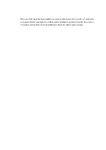Tracing the Compositional Process. Sound art that rewrites its own past: formation, praxis and a computer framework
| dc.contributor.supervisor | Miranda, Eduardo Reck | |
| dc.contributor.author | Rutz, Hanns Holger | |
| dc.contributor.other | Faculty of Arts, Humanities and Business | en_US |
| dc.date.accessioned | 2014-09-22T09:58:23Z | |
| dc.date.available | 2014-09-22T09:58:23Z | |
| dc.date.issued | 2014 | |
| dc.identifier | 10254321 | en_US |
| dc.identifier.uri | http://hdl.handle.net/10026.1/3116 | |
| dc.description.abstract |
The domain of this thesis is electroacoustic computer-based music and sound art. It investigates a facet of composition which is often neglected or ill-defined: the process of composing itself and its embedding in time. Previous research mostly focused on instrumental composition or, when electronic music was included, the computer was treated as a tool which would eventually be subtracted from the equation. The aim was either to explain a resultant piece of music by reconstructing the intention of the composer, or to explain human creativity by building a model of the mind. Our aim instead is to understand composition as an irreducible unfolding of material traces which takes place in its own temporality. This understanding is formalised as a software framework that traces creation time as a version graph of transactions. The instantiation and manipulation of any musical structure implemented within this framework is thereby automatically stored in a database. Not only can it be queried ex post by an external researcher—providing a new quality for the empirical analysis of the activity of composing—but it is an integral part of the composition environment. Therefore it can recursively become a source for the ongoing composition and introduce new ways of aesthetic expression. The framework aims to unify creation and performance time, fixed and generative composition, human and algorithmic “writing”, a writing that includes indeterminate elements which condense as concurrent vertices in the version graph. The second major contribution is a critical epistemological discourse on the question of ob- servability and the function of observation. Our goal is to explore a new direction of artistic research which is characterised by a mixed methodology of theoretical writing, technological development and artistic practice. The form of the thesis is an exercise in becoming process-like itself, wherein the epistemic thing is generated by translating the gaps between these three levels. This is my idea of the new aesthetics: That through the operation of a re-entry one may establish a sort of process “form”, yielding works which go beyond a categorical either “sound-in-itself” or “conceptualism”. Exemplary processes are revealed by deconstructing a series of existing pieces, as well as through the successful application of the new framework in the creation of new pieces. | en_US |
| dc.language.iso | en | en_US |
| dc.publisher | Plymouth University | en_US |
| dc.subject | Computer music | en_US |
| dc.subject | Sound art | en_US |
| dc.subject | Data structures | en_US |
| dc.subject | Electroacoustic music | en_US |
| dc.subject | Composition process | en_US |
| dc.title | Tracing the Compositional Process. Sound art that rewrites its own past: formation, praxis and a computer framework | en_US |
| dc.type | Thesis | |
| plymouth.version | Full version | en_US |
| dc.identifier.doi | http://dx.doi.org/10.24382/3447 |
Files in this item
This item appears in the following Collection(s)
-
01 Research Theses Main Collection
Research Theses Main


